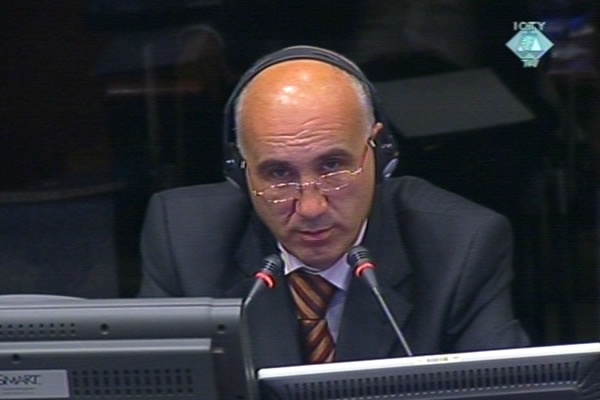Home
TIME OF ‘PLAGUE’ IN PALE
In his evidence at the trial of Radovan Karadzic, Hajrudin Karic described the heavy beating and other abuse he and about 100 other Muslims suffered in captivity, first in Pale and then in the Kula prison. Police chief Malko Koroman visited the prisoners in Pale once and nonchalantly remarked that the hall where the prisoners were held looked ‘like an outbreak of the plague’. In Kula prison, Karadzic personally visited the prisoners
 Hajrudin Karic, witness at the Radovan Karadzic trial
Hajrudin Karic, witness at the Radovan Karadzic trial Former Centrotrans employee Hajrudin Karic described at the trial of Radovan Karadzic the heavy beatings and other abuse he suffered together with about 100 other Muslims. From May to late August 1992 Karic was held captive first in the Culture Hall in Pale and then in the Kula prison in Lukavica. The prisoners were treated brutally in Pale and many prisoners that the soldiers and police officers took away in order to beat them never returned.
The witness’s written statement was admitted into evidence. The witness notes in his statement that on 22 May 1992 employees of Muslim ethnicity were laid off en masse in Pale. Many of them were arrested and others were expelled together with their families to Sarajevo. Karic was arrested in late May 1992 in the apartment of his uncle in Pale. Karic was detained with the others in the Culture Hall. He was told that his wife’s brother allegedly took part in the fighting against Serbs.
One day, two Serb soldiers with wooden bats entered the hall where the prisoners were and took Karic away to another room. ‘They beat me on the back and head until I fell down’, the witness said. At one point, Karic lost consciousness from numerous blows. The beating stopped when Milomir Tepes came into the room. ‘Not him, that’s not him’, Tepes said. Karic was taken back to the hall and lay there helpless for several days.
The witness recounted that on another occasion, police chief in Pale Malko Koroman arrived in the hall where the prisoners were kept. ‘What’s this, this place looks like an outbreak of the plague’, Koroman said when he saw the dead body of a youth whose brains were seeping out onto the wooden floor. Two other men had died after the beatings around that time and their bodies lay there on the floor among the prisoners. ‘Mostly we all lay on the floor because nobody could stand on their feet’, the witness explained.
Karic and the other surviving prisoners were transferred to the Kula prison in Lukavica on 11 July 1992. That year Karadzic visited the Kula prison; he was accompanied by British politician Paddy Ashdown, representatives of the International Red Cross and journalists. The prosecution corroborated this with a report on the visit broadcast by CNN.
The witness said that the Kula prison, where women and children were among the detainees, ‘tidied up a bit’ before the visit. However, after the visit the situation didn’t improve: prisoners were still taken out to do forced labor and lived on subsistence rations: one slice of bread and bad soup. Only 34 of the prisoners were still alive on 28 August 1992 when the witness was exchanged. The witness lost 50 kilos in the three months.
In the cross-examination, Karadzic tried to prove that Muslims were not arrested in Pale without reason. They were not civilians but ‘armed rebels’ who refused to surrender arms. Karadzic also noted that on 22 May 1992, two Serb police officers were killed in the village of Hrenovica as they were collecting illegal arms. On 25 May 1992, the brother of the witness’s wife, Ibro Salihspahic and some other men ‘slaughtered the elderly women and men’ in the Serb villages of Vukasinovici and Leleci, Karadzic noted.
Karadzic will continue the cross-examination of Hajrudin Karic tomorrow morning.
Linked Reports
- Case : Karadzic
- 2011-06-22 ‘FRATERNAL RELATIONS’ BETWEEN THE SDS AND SERBIAN OFFICERS IN THE JNA
- 2011-06-21 KARADZIC’S COMMUNICATIONS DURING THE WAR
- 2011-06-20 DID COMMUNICATIONS IN REPUBLIKA SRPSKA FUNCTION?
- 2011-06-24 KARADZIC DISTANCES HIMSELF FROM DERONJIC
- 2011-06-28 ‘HELL’ ORCHESTRATED BY SDS
- 2011-06-29 DID KARADZIC ARREST OR RELEASE ‘YELLOW WASPS’?
